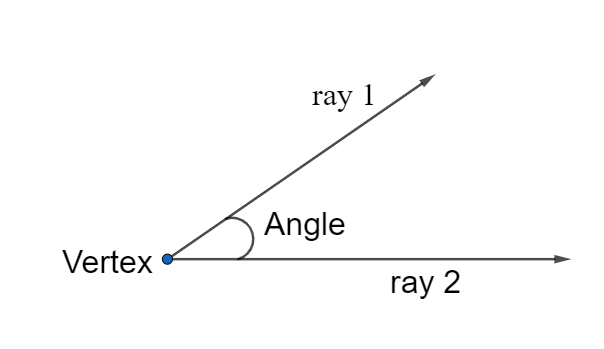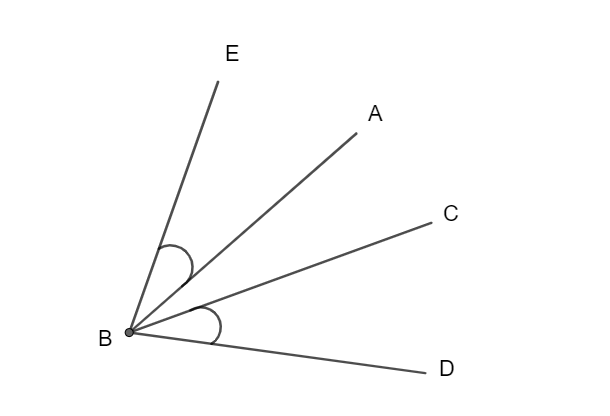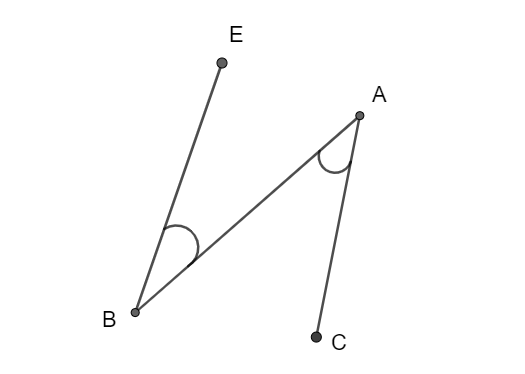
Define adjacent angle.
Answer
584.1k+ views
Hint: First of all, know the definition of an angle. And then know the definition of adjacent angles and later on find the conditions for the angles in order to prove them as adjacent angles.
Complete step by step solution:
Here, we have to define what an adjacent angle is?
But before defining adjacent angles, we have to know what angle is.
So, now let us define angle.
Definition (angle): An angle is the figure formed by joining two rays, sharing a common endpoint in a geometric plane. Where the rays are called the sides of the angle and the common end point is said to be the vertex of the angle.

Here in the above figure you can see how angle is formed by joining two rays. As defined in definition the two rays, ray 1 and ray 2 are said to be sides of the angle and the common point is said to be the vertex of the angle.
angles are also formed by the intersection of two planes, intersection of two curves in a plane and in many other ways.
Now proceeding further let’s see the definition of adjacent angle.
Definition (adjacent angle): Two angles have a common side with a common point (common vertex) without overlapping of angles, then the angles are said to be adjacent angles.

Angle ABC and CBD are said to be adjacent angles.
Because of three reasons:
1. They have a common line or common side CB as mentioned in the definition of adjacent angle
2. They have a common point or common vertex B as mentioned in the definition of adjacent angle.
3. The angles are not overlapped as mentioned in the definition.
Let us look at some examples for adjacent angles.

The angles EBA and CBD in the above figure are not adjacent angles because they share a common vertex but not common side. Therefore these two angles are not adjacent.

The angles EBA and BAC in the above figure are not adjacent angles because they share a common side but not common vertex. Therefore these two angles are not adjacent.
Note: Students may make mistakes while writing the angles. i.e. the vertex where the angle is located is written in the middle. For example in the above figure angle is located at B and A vertices, so while writing angles we have to write like EBA and BAC. Students may find the overlapped angles and they can treat them as adjacent angles but from the definition overlapped angles are not considered as adjacent angles.
Complete step by step solution:
Here, we have to define what an adjacent angle is?
But before defining adjacent angles, we have to know what angle is.
So, now let us define angle.
Definition (angle): An angle is the figure formed by joining two rays, sharing a common endpoint in a geometric plane. Where the rays are called the sides of the angle and the common end point is said to be the vertex of the angle.

Here in the above figure you can see how angle is formed by joining two rays. As defined in definition the two rays, ray 1 and ray 2 are said to be sides of the angle and the common point is said to be the vertex of the angle.
angles are also formed by the intersection of two planes, intersection of two curves in a plane and in many other ways.
Now proceeding further let’s see the definition of adjacent angle.
Definition (adjacent angle): Two angles have a common side with a common point (common vertex) without overlapping of angles, then the angles are said to be adjacent angles.

Angle ABC and CBD are said to be adjacent angles.
Because of three reasons:
1. They have a common line or common side CB as mentioned in the definition of adjacent angle
2. They have a common point or common vertex B as mentioned in the definition of adjacent angle.
3. The angles are not overlapped as mentioned in the definition.
Let us look at some examples for adjacent angles.

The angles EBA and CBD in the above figure are not adjacent angles because they share a common vertex but not common side. Therefore these two angles are not adjacent.

The angles EBA and BAC in the above figure are not adjacent angles because they share a common side but not common vertex. Therefore these two angles are not adjacent.
Note: Students may make mistakes while writing the angles. i.e. the vertex where the angle is located is written in the middle. For example in the above figure angle is located at B and A vertices, so while writing angles we have to write like EBA and BAC. Students may find the overlapped angles and they can treat them as adjacent angles but from the definition overlapped angles are not considered as adjacent angles.
Recently Updated Pages
Master Class 9 Social Science: Engaging Questions & Answers for Success

Master Class 9 Science: Engaging Questions & Answers for Success

Master Class 9 English: Engaging Questions & Answers for Success

Master Class 9 Maths: Engaging Questions & Answers for Success

Master Class 9 General Knowledge: Engaging Questions & Answers for Success

Class 9 Question and Answer - Your Ultimate Solutions Guide

Trending doubts
Which places in India experience sunrise first and class 9 social science CBSE

Fill the blanks with the suitable prepositions 1 The class 9 english CBSE

Write the 6 fundamental rights of India and explain in detail

Difference Between Plant Cell and Animal Cell

What is pollution? How many types of pollution? Define it

What is the Full Form of ISI and RAW




